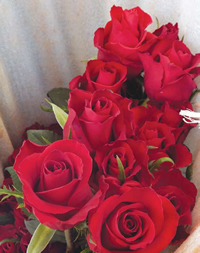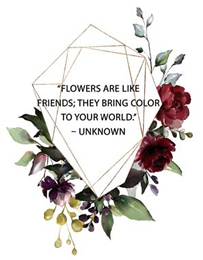February 14th is upon us. It is Valentine’s Day; a day marked by lovers, friends and family to show affection by swapping such presents as flowers, cards, chocolates and other expressive, if not romantic gifts
 But first, the ever fascinating Valentine’s story
But first, the ever fascinating Valentine’s story
There exists several tales about the origin of Valentine’s Day, and nobody knows if they are factual. The most famous ones all have endings. The first one is about the young Valentine, who was a victim of his belief on February 14 of the year 270. He, a Roman, converted to Christianity and by doing so offended the Roman leaders. On February 14 Valentine was tortured and beheaded. However, he succeeded in giving the daughter of the prison warder a note just before he died. The note contained the legendary text ‘From your Valentine; forever marking february the 14th as a day of love displays.
Another story is about a priest in Rome named Valentine. An emperor named Claudius II had forbidden the Roman soldiers to marry, because he was of the opinion that unmarried men were better soldiers. Priest Valentine ignored this rule and united young couples into marriage. The emperor found out about this and imprisoned Valentine and sentenced him to death.
It is all Red
The big rush is over. In the weeks leading up to February 14th, growers worked around the clock to harvest and ship their flowers, and at the beginning of the week, the final Valentine’s flowers left the farm. Also at the FloraHolland auction in Rijnsburg and Aalsmeer, the same trend happened. “The overall picture this year was moderate to good”, says Amerik de Best, auctioneer at Rijnsburg. “In general, the quality was good and red received good prices at Rijnsburg. White was also doing quite well, but other colours trailed behind.”
No Valentine’s prices for red roses
The prices of red roses are ideally very high towards Valentine’s Day but that was not the case this year. In the previous years it has been possible to achieve good prices translating to about a cent per centimeter. This year red roses Valentine’s prices at the auction have been unspectacular. The prices did no go up in the last week of January as is typical.
Prices were under pressure at the auction for non-red roses ,especially the yellow and orange variaties. Looking at the product portfolio better Valentine’s worthy prices for the spray roses in 60- 70-80cm.”
But what could have been the reason for the low prices? The reason for these low prices could be attributed to high supply and low demand. There were favourable weather conditions in Kenya and Ethiopia resulting in very good production, and poor prices in the last quarter of 2018 led many growers to flush their crop in anticipation for good Valentine’s prices, effectively contributing to the above normal production levels. The subzero temperatures in Europe also hampered distribution logistics and outdoor sales.
 Volumetric weight
Volumetric weight
Other than the lower prices, Kenyan growers also have had to deal with higher freight costs as a result of the volumetric weight charging formula for freight that took effect from June 2018, coupled with higher freight charges that come with the extra capacity delivered during Valentine’s. Consequently growers end up with a very low and sometimes even negative return.
Let’s go on a quick tour around the world. How was the supply from Africa and South America, what were the challenges, and how did it go in terms of logistics, handling and sales in various parts of the world?
Kenya
In Kenya, we heard most complaints regarding the exorbitantly high freights costs, as a result of the volumetric weight charging formula for freight that took effect from June 2018. On top of that, the freight charges that came with the extra capacity delivered during Valentine’s had an effect on the return of growers, Yvonne Tirop of Sian Roses said. Also Isabelle Andre of Red Lands Roses confirmed the higher price pressure. She also points out the poor handling of documents by shipping agents and poor handling of cargo agents. Furthermore, growers were satisfied with the quality of the roses and the prices for pre-sale orders on the direct market. According to Tirop, the pre-sale prices were the best this year.
Ethiopia
In Ethiopia, not everyone was similarly enthusiastic. Esayas Kebebe of Agri-Lake Flowers, who grows roses in Bahar Dar and Holeta and supplies them to the Dutch auction, complained about the disappointing prices on the clock. “The weather conditions in both Kenya and Ethiopia was good, last year the temperature was cold and there was a shortage of water in Kenya. Additionally it might be some of the Holland growers supplied flowers that are not roses, which is different from the past years.”
However, the fact that Valentine’s Day fell on a Thursday this year is positive. “It is four days after the weekend, which is good for the buyers to have and to distribute flowers slowly.”
But Valentine’s Day is not the most important day of the year for all growers. “The Valentine’s season is not that important to us”, says Wim Ammerlaan of AQ Roses, who grows roses in Ziway. “In Ethiopia, we usually do not have top production during this time of the year due to the relatively cold temperatures in December and January. Last year, the effects were extreme. This year it has not been that cold and the production continued well. We therefore do not specifically focus on Valentine’s Day, but we choose for a year-round stable production with uniform quality.”
 Ammerlaan also points out that the price levels were very mediocre. “It seems that the peak is becoming shorter because the pressure from retail buyers is decreasing. Exporters focused on the wholesale and florists also seem to sell more flowers in a shorter time frame. Since September, we are noticing that the total demand is below average. But this is also partly the result of the challenging production year of 2018, with many quality based problems from Kenya and the extremely cold spring in Ethiopia. The popularity of a rose bunch in the supermarket has fallen compared to the past from the start of January, shops have been filled with tulips. Are too many roses entering Europe of which they do not know for whom they are produced?”
Ammerlaan also points out that the price levels were very mediocre. “It seems that the peak is becoming shorter because the pressure from retail buyers is decreasing. Exporters focused on the wholesale and florists also seem to sell more flowers in a shorter time frame. Since September, we are noticing that the total demand is below average. But this is also partly the result of the challenging production year of 2018, with many quality based problems from Kenya and the extremely cold spring in Ethiopia. The popularity of a rose bunch in the supermarket has fallen compared to the past from the start of January, shops have been filled with tulips. Are too many roses entering Europe of which they do not know for whom they are produced?”
He also noticed that there were many red roses available on the clock early this year, which in turn resulted in the prices never reaching their estimated level. “Besides, we saw that the colors yellow and pink received very low prices in the run-up. Hopefully, with a steadier supply towards Women’s Day, better price levels shall be realized.”
Netherlands
In Holland, they’ve had quite some good weather. Production was up and prices were reasonable. However, the Dutch rose growers struggle to cope with the huge volumes entering the market, from especially Kenya and Ethiopia. “In the past – say up to five to ten years back – the African rose growers mainly produced small headed roses”, Dutch rose grower Aad Fransen of Fransen Roses tells us. “Since then, more and more varieties have been introduced, giving them the capacity to produce medium to large-headed roses. This is making things tough, especially since we need a certain price to level with the higher energy and price intensive production we have here. Talking revenue, prices for Red Naomi, averaged about 15% lower this year as compared to previous Valentine’s days.”
Colombia
According to Asocolflores, the Association of Colombian Flower Exporters, around 35,500 tons of flowers were sent out of Colombia, with the majority going to the US – 78% of the US imported flowers are grown in Colombia. Over a quarter of the exported flowers left Colombia as ready to sell, finished bouquets. Out of this country, 600 million stems of more than 1,600 varieties are exported, with Miami being the main destination. The good market behaviour during Valentine’s Day was essential for the sector to achieve a 5.1% rise in its 2018 exportation (in tons).
When we ask growers, transport is again a dominant subject. One of the growers, David Quesada of Inverpalmas (who grows roses, carnations and mini carnations in the savanna near Bogota), was satisfied with this year’s Valentine’s Day. “Even though production was not what we expected, our sales numbers were not bad at all.” He also tells us that the demand was not low but the buyers were not desperate to get flowers. “I think Ecuador’s production was a little early, while we were a bit behind on some colours – it did not rain but we did not have clear skies either as usual. I think this may have delayed the rose production a bit, but the good thing is that it did not delay it enough to be inconvenient. It gave us the time to fulfill our customer’s orders. Fortunately, we had some help from customers to move a few orders a couple of days to give the flowers some time to bloom at the greenhouses.” And prices were good. “Since production was not very high, our customers and their customers did not have a problem to paying a good price.”
Regarding logistics, he mentions the limited air space for the flowers as a challenge. “Because of this, we needed to have everything ready at the farm on time. It was a bit stressful, but at the end of the day we worked together with our customers. They offered great support, and we were able to make it; working as a team.”
Juan Camilo Sanz of Macarena Farms, whose wholesale flower growers operate in the Colombian Andes Mountains, is less positive. He is not satisfied with Valentine’s Day this year. “The weather was not good; sunlight was poor as it was very cloudy. These very cloudy days resulted in a delayed production.”
Ecuador
Out of Ecuador, about 15,000 tons of flowers were sent abroad to meet the demand of Valentine’s Day. The sector has a new boarding point this year thanks to the resumption of cargo flights at Cotopaxi International Airport. The export increased by around 1,000 tons in relation to the shipment that was made for the same holiday, in 2018, the Ecuador Times revealed. The flowers, 92 percent of which are roses, went to the US, the Netherlands, Luxembourg, Russia, and Qatar.
From some Ecuadorian growers, we heard some relatively positive reactions. “I am 80% satisfied”, says Antonio Bueno of Sisapamba (a rose grower in Cayambe). “The open market was over-served and too many roses were available, causing the prices for the open market to drop – they were about 10% lower than last year.” The demand was actually very high for pre-bookings. “Clients this year wanted to book as much as possible. However, as mentioned before, the open market availability meant it was very difficult to sell.”
To manage the crops to start getting ready just on time and not too early, and trying to sell at the best possible price in the face of the open market availability was the main challenge according to Bueno. But all in all, he does not have any weather complaints. “It was very warm and dry, so very good this year.”
Valeria Lobato Jarrin of Florpaxi, who grows roses in Tanicuchi – Lasso in the province of Cotopaxi, is also satisfied. “We sold all our production and also our pre-orders – we felt that the demand increased this year. Additionally, our flowers were allocated to new markets and new clients, which is always something positive.” Next to demand, she is also pleased with the prices. “Prices were higher than in the regular season. These are the price ranges we managed last year as well.”
The weather, however, was vreally unpredictable. “We felt that this year, the weather conditions were more unstable than last year. We faced very sunny days followed suddenly by very rainy days and vice-versa. In our opinion, the fluctuating weather in Ecuador was a big challenge.”
 Gino Descalzi of Fiorentina Flower (another rose grower from Cayambe) told the Ecuadorian Times that the hot weather that occurred during this rainy season advanced the production in the flower farms and, as a result, there is an abundance of flowers in the market. “Due to the large amount of production, the price dropped.” To conclude, Jarrin said that the extreme cold wave that occurred in the USA resulted in some cancelled flights.
Gino Descalzi of Fiorentina Flower (another rose grower from Cayambe) told the Ecuadorian Times that the hot weather that occurred during this rainy season advanced the production in the flower farms and, as a result, there is an abundance of flowers in the market. “Due to the large amount of production, the price dropped.” To conclude, Jarrin said that the extreme cold wave that occurred in the USA resulted in some cancelled flights.
Conclusion
A combination of factors have made Valentine’s Day a challenge this year. There is a lot of product in the market and the demand isn’t great. As a result, the prices at the auction are lower than ever before during this time of the year. On top of that, Kenyan growers have had to deal with the higher freight costs.
